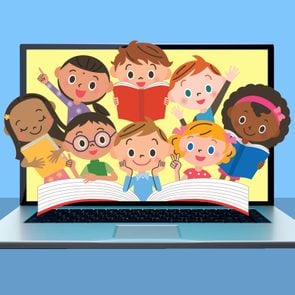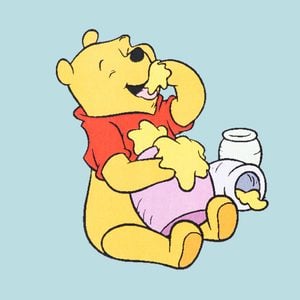If you grew up in the 1990s, you might remember a children’s book about a fish with beautiful rainbow scales. While the book’s title (The Rainbow Fish, naturally) and plot may be a little murky after decades, its art—depicted with gorgeous colors and sparkly holographic foil—has no doubt lingered in your memory. Though it has a straightforward premise, the kids’ story is now at the center of a so-called Rainbow Fish controversy, thanks to a problematic message hidden beneath its surface.
Back in January 2023, one teacher posted his hot take on the children’s book on TikTok, and it sparked a larger conversation about some of the story’s shortcomings and missed opportunities for teaching lessons about humility and acceptance. Whether you think it’s one of the best books for kids or have a less favorable view of the story, it’s worth exploring the issues. Read on to understand the Rainbow Fish controversy and why the book might not hold up in modern classrooms.
Join the free Reader’s Digest Book Club for great reads, monthly discussions, author Q&As and a community of book lovers.
What is The Rainbow Fish about?
Written and illustrated by Marcus Pfister, The Rainbow Fish is an award-winning 1992 children’s picture book that spawned a New York Times bestselling book series, a 1997 short film and an animated TV series that ran for one season in 2000.
The main message of the book is about sharing with others rather than being selfish. The book’s protagonist, Rainbow Fish, has beautiful scales that are unique from all the other fish. Because of his rainbow scales, he sees himself as better than the fish around him. In fact, he is so vain that he refuses to share his scales with the other fish when they ask.
Since Rainbow Fish refuses to share, the other fish decide not to play with him. But after speaking with the wise octopus, who tells him he must share, Rainbow Fish gives one of his scales each to the other fish, and their friendship is restored.
How was the book initially received?
The book is unquestionably popular with kids, who seem to gravitate toward the fish’s iridescent foil scales. More than 30 million copies of The Rainbow Fish have sold worldwide, according to Publishers Weekly.
The picture book was an awards hit too. In 1993, the book won a Christopher Award, which, according to the competition’s website, recognizes media that “affirm the highest values of the human spirit” and “encourage audiences to see the better side of human nature.” Two years later, it won the American Booksellers Book of the Year (ABBY) Award for children’s books. The Rainbow Fish was also an International Literacy Association/Children’s Book Council “Children’s Choice” book, following a vote by 12,500 children across the United States.
But despite the awards and impressive sales figures, (adult) critics’ responses to The Rainbow Fish were tepid. Ellen Fader of School Library Journal wrote, somewhat favorably, that “this is certainly a story written to convey a message, but in its simplicity, it recalls the best of [children’s book author and illustrator Leo] Lionni. Besides, what 3-year-old doesn’t need reinforcement about sharing?” But the Publishers Weekly review said that the “cautionary tale about selfishness and vanity has trouble staying afloat” and noted that “the translation from the original German text doesn’t enhance the story’s predictable plot and lapses into somewhat vague descriptions.”
What is the Rainbow Fish controversy?
Although The Rainbow Fish‘s theme of selfishness versus sharing sounds harmless enough, there are underlying problems that some teachers, parents and critics have pointed out over the years. Among them is TikTok creator and elementary school teacher Mr. Vương (@teamvuong), who shared his opinion on The Rainbow Fish in a TikTok video that’s received over 720,700 views and over 37,800 likes as of publication.
In some ways, The Rainbow Fish could have been a children’s book about diversity: The Rainbow Fish has metallic scales that the other fish do not. Instead, as Vương pointed out, the message is problematic because, in giving away pieces of himself, Rainbow Fish is buying friendship. In other words, the friendships he gains through sharing his scales is conditional. (In case you’re wondering: No, the book never explains why one fish would ask another for a part of its body.)
“I think the story would’ve worked better if they just played on Rainbow Fish’s character flaw, which was that he was not humble and that he thought he was better than everybody,” Vương said in the video. “But this happens: When Rainbow Fish said ‘no’ and drew a boundary, all the other fish decided not to play with him. That made it more about how all the other fish didn’t accept him because he didn’t give up his scales, rather than them responding to his stuck-up behavior.”
In Vương’s interpretation of the story, Rainbow Fish is finally accepted by others because he “gave up parts of who he was” and “had to change to get others to like him,” he said.
What are others saying about The Rainbow Fish?
Vương read The Rainbow Fish to his students without sharing his opinion of the book with them. Some of the children reached the same conclusion that he did—that Rainbow Fish has to change himself or “buy” acceptance. Other kids read it as a message of selfishness. In his video, Vương added that he loved using the book as a critical-thinking teaching tool to encourage kids to dive deeper into The Rainbow Fish‘s theme.
Meanwhile, in Vương’s comment section, many people agreed with his take on the book, while others remained firm in their belief that children cannot read that deeply into a story.
Other teachers have said similar things as Vương about The Rainbow Fish, including a Montessori preschool teacher named Megi (@megi_learn_and_play), who shared a video on TikTok explaining why she refuses to read certain children’s books to her students.
@megi_learn_and_play In recent years, there has been a movement in early years settings to remove certain books from their collections. This is often due to concerns over the messages that these books may convey, and a desire to promote more inclusive and diverse representation in children’s literature. there is many books that have amazing stories and will stay in my shelves for years to come. #eyfs #preschoolteacher ♬ original sound – Megi | Early Years Educator
While Vương’s video sparked a debate on the book in 2023, the Rainbow Fish controversy has been around much longer than that. In fact, the New York Times referred to The Rainbow Fish as “perhaps the most polarizing book written for children” in a 2014 article, noting that, to its fans, it’s a story about a fish who learns a lesson in humility, but to its “detractors, it’s a socialist screed.”
The book’s author has denied imbuing the story with a hidden meaning or agenda. “The Rainbow Fish has no political message,” Pfister wrote on his website. “The story only wants to show us the joy of sharing.”
How should parents approach The Rainbow Fish?
Don’t let the Rainbow Fish controversy fool you into thinking this book is best removed from shelves. In a follow-up video, Vương made clear that this wasn’t his goal. “At the heart of it, all I wanted to do was to teach my students how to think critically about the books they read and about their world,” he said. He went on to explain why he opposes book banning, and parents can learn a lot.
If you disagree with The Rainbow Fish‘s message, use the book to explain why you don’t agree with the message and teach your kids how to think critically about the books and media they consume.
Get Reader’s Digest’s Read Up newsletter for more books, humor, travel, tech and fun facts all week long.
Why trust us
At Reader’s Digest, we’ve been sharing our favorite books for over 100 years. We’ve worked with bestselling authors including Susan Orlean, Janet Evanovich and Alex Haley, whose Pulitzer Prize–winning Roots grew out of a project funded by and originally published in the magazine. Through Fiction Favorites (formerly Select Editions and Condensed Books), Reader’s Digest has been publishing anthologies of abridged novels for decades. We’ve worked with some of the biggest names in fiction, including James Patterson, Ruth Ware, Kristin Hannah and more. The Reader’s Digest Book Club, helmed by Books Editor Tracey Neithercott, introduces readers to even more of today’s best fiction by upcoming, bestselling and award-winning authors. We verify all facts and data, back them with credible sourcing and revisit them over time to ensure they remain accurate and up to date. Read more about our team, our contributors and our editorial policies.
Sources:
























